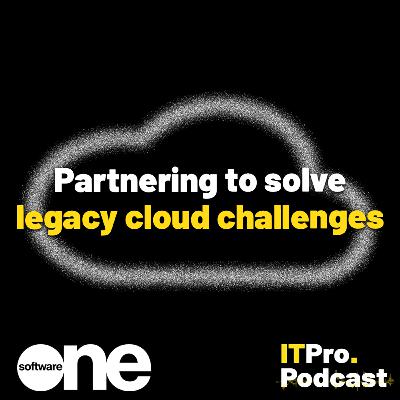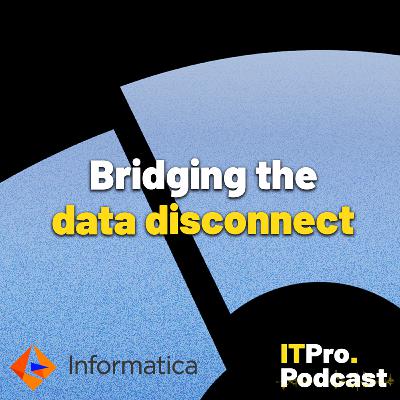Discover The ITPro Podcast
The ITPro Podcast

The ITPro Podcast
Author: ITPro
Subscribed: 117Played: 3,796Subscribe
Share
© 337677
Description
The ITPro Podcast is a weekly show for technology professionals and business leaders. Each week hosts Rory Bathgate and Jane McCallion are joined by an expert guest to take a deep dive into the most important issues for the IT community. New episodes premiere every Friday. Visit itpro.com/uk/the-it-pro-podcast for more information, or follow ITPro on LinkedIn for regular updates.
336 Episodes
Reverse
HPE Discover Barcelona 2025 was in full swing this past week, with thousands of attendees descending on the Fira Barcelona to hear the latest news on the networking, servers, storage, supercomputing – and, of course, AI.It’s a pivotal time for the firm, as it consolidates its hardware partnerships and heralds a recent acquisition, while laying out its strategy to help customers not only meet demand, but expand their networks and adopt new technologies.What are some of the biggest things HPE announced – and what does the firm have lined up for 2026 and beyond?In this episode, Rory interviews Jane live on the ground to unpack all things HPE.
As a business leader, you’d like to believe that your staff are entirely trustworthy. Effective enterprises run on workforce confidence – but in some cases, that trust can be misplaced.In November, CrowdStrike admitted one of its own employees had provided screenshots of internal systems to hackers in exchange for a sizable payout. Industry experts have told ITPro the incident should act as a wake up call to the all-too-serious risk of insider threats.Earlier in the month, websites all over the world went offline after a major outage at the content delivery network service provider Cloudflare. What was the cause of the incident: had Cloudflare fallen victim to the kind of DDoS attack it’s famous for preventing?In this episode, Jane and Rory welcome back Ross Kelly, ITPro’s news and analysis editor, to explore some of November’s biggest stories.FootnotesIf you're not taking insider threats seriously, then the CrowdStrike incident should be a big wake up callNearly 700,000 customers impacted after insider attack at US fintech firmAI means cyber teams are rethinking their approach to insider threats‘Insiders don’t need to break in’: A developer crippled company networks with malicious code and a ‘kill switch’ after being sacked – and experts warn it shows the huge danger of insider threatsEverything you need to know about CloudflareThe Cloudflare outage explained: What happened, who was impacted, and what was the root cause?Cloudflare says AI companies have been “scraping content without limits” – now it’s letting website owners block crawlers and force them to paySecurity experts issue warning over the rise of 'gray bot' AI web scrapersCloudflare is fighting back against AI web scrapersNearly half of all digital initiatives still fail – here’s how you can learn from the ‘digital vanguard’ and deliver successSubscribe to the IT Pro newslettera...
It seems that everywhere you look these days, businesses are implementing AI features, tools, chatbots, and pilots. But researchers keep coming to the same conclusion about the benefits of enterprise AI adoption – that return on investment is slim to none.While this isn’t the case for every business, it’s certainly a worry that hangs over discussions of the technology. The secret to making AI projects succeed is knowledge that every leader is after right now – and knowing what not to do is just as important.Where are businesses going wrong with AI adoption? And how can they apply the learnings of the past few years to ramp up return on investment?Today, we’re joined by Alan Trefler, founder and CEO at Pegasystems, to unpack the main hurdles businesses face when it comes to AI adoption – and why AI failure is becoming such a widespread concern.In this episode, Jane and Rory speak to Alan Trefler, founder and CEO at Pegasystems, to unpack the main hurdles businesses face when it comes to AI adoption – and why AI failure is becoming such a widespread concern.
The dream of every small-to-medium business is to harness one’s success and turn it into sustainable growth – expanding operations, hiring more workers, and delivering more value to a wider customer base.But achieving this in the modern enterprise environment requires as much focus on IT strategy as business strategy. Without the right approach to cloud, technology, and cybersecurity, businesses will struggle to scale past a point. Camp Australia knows this better than most. When the leading provider of Outside School Hours Care in Australia came to the conclusion that its decades-old IT and cloud processes were holding it back from unlocking its full scalability, it partnered with SoftwareOne to migrate to Microsoft Azure and adopt the benefits of a unified cloud environment.How did SoftwareOne help Camp Australia achieve these goals? And what are the key lessons to be taken away from this successful transformation project?In this episode, in association with Hyland, we’re speaking to Justin Itin, Sales Lead at SoftwareOne and Peter Lane, CTO at Camp Australia, to explore Camp Australia’s digital transformation project and how SoftwareOne helped facilitate it.Read more:Find out more about SoftwareOneFind out more about Camp Australia
This episode was first published on 10 January 2025.Anyone who works outside of a major city, or has ever tried to get work done while on a trip to a more rural location, knows that rural connectivity can be patchy. Despite the UK’s high population density and relative lack of difficult terrain, rural connectivity remains an uneven picture. Many rural businesses are still struggling to receive fiber optic cables, let alone leverage 5G signals to keep up with the demands of modern business.Is UK connectivity improving? And how far have we still got to go?In this episode, Jane and Rory speak to David Happy, non-executive director at JET Connectivity and non-executive chairman for transport at Wales Fiber, and Colin Wood, innovation lead at Dorset Council, to better understand the state of rural connectivity in the UK.Read more:UK rural businesses set for broadband improvementsInvest 2035: the UK's modern industrial strategyUK gov has ramped up broadband roll-outs to tackle 'hard-to-reach' areas in 2023BT and OneWeb succeed in "game changer" satellite connection trialThe battle for space broadband dominance is hotting upUK government to run Starlink trials in Snowdonia, Lake District
The end of October was punctuated with a series of major cloud outages, first at AWS and then at Microsoft, bringing a wide range of websites and business applications offline.In the previous episode, we spoke about this in a reactive sense – the immediate customers impacted and the likely causes.But it's also important to break the problem down at a strategic and technical level. Just how do outages at this scale occur – and what’s it like as an insider, fighting to bring services back online?In this episode Rory speaks to James Kretchmar, SVP & CTO of the cloud technology division at Akamai Technologies, to get an insider’s perspective on cloud outages and how businesses can navigate these incidents.Read more:Amazon Web Services outage live: Hundreds of apps including Slack, mobile carriers, banking services downThe AWS outage brought much of the web to its knees: Here's how it happened, who it affected, and how much it might costThe Microsoft Azure outage explained: What happened, who was impacted, and what can we learn from it?Australia internet banking outage blamed on DDoS mitigation serviceWhy the CrowdStrike outage was a wakeup call for developer teams
The global services market is expected to grow at 8% compound annual growth between now and 2028, representing a $1.7 trillion opportunity.But partners looking to seize on this opportunity face a slew of challenges. Establishing a services offering for customers demanding the scale of the cloud and complex technologies like AI is difficult without the right service provider, for example.Whether you're already offering cutting edge IT services or just scaling within your region, it's a huge benefit to get a helping hand with pre-sales, managed services, and ongoing support.What does this look like in practice, and who can partners turn to? In this special edition of the ITPro Podcast, in association with TD Synnex, Jane and Rory speak to Stephen Ennis, VP of Technology Acceleration at TD Synnex.
It’s Halloween! And what better way to mark the day than discuss one of the biggest horror stories of October?We are of course referring to the AWS outage, which on 20 October took down some incredibly notable websites and caused global disruption. It’s the latest, most severe example of why data centers are considered critical infrastructure – and acts as a stark reminder to IT administrators that even big tech can fall foul of technical errors.Of course, October hasn’t just been defined by negative stories. At the end of the month, the US Department of Energy has revealed a slew of supercomputer announcements. What are they for, and when can they be expected to be up and running?In this episode, Jane and Rory once again welcome Ross Kelly, ITPro’s news and analysis editor, to the show to discuss the biggest developments of the month.
Business software is evolving faster than ever before, with advancements such as AI spurring developers to introduce new ways of working and interacting with the software layer.But by and large, business hardware has stayed much the same for the past decade. With a few notable exceptions, the laptops, desktops, and portables we use for work today are simply evolved versions of what we were using in 2015.Is this set to change? And what could the hardware of the future look like?In this episode Rory speaks to Bobby Hellard, ITPro’s reviews editor, to explore some of the latest advances in business hardware and ask – is this the best it gets?Read more:The Huawei MateBook Fold Ultimate Edition is a unique take on what it means to be a laptop – but good luck getting it outside of ChinaE-ink is on-trend and I'm all for itReMarkable Paper Pro review: The e-ink color tablet that lets you thinkThe ReMarkable Paper Pro Move gives you e-ink in a pocketable package – but it's not without faultSupernote A5 X2 Manta review: A premium e-ink tablet that's still somewhat SpartanThe Amazon Kindle Scribe is no bullet journal – it is, in fact, a fairly basic E Ink tablet
San Francisco has played host this week to one of the biggest tech conferences of the year, Salesforce Dreamforce. The stalwart event has seamlessly transformed from being all about cloud for the best part of 20 years to being heavily AI focused in the past two years.What can we learn from the pronouncements – and contradictions – being delivered on stage this year?In this episode Jane speaks to Rory, who has been on the ground this week reporting from Salesforce Dreamforce 2025.Highlights"This year is part two of the hard turn into AI agents. Ross wrote a great piece last year on how Agentforce is kind of intended to be Salesforce's Chat GPT moment. So this is Salesforce's dedicated AI agents platform – platform kind of undersells how extensive it is. It's not just like a marketplace for agents, for example. It's kind of a marketplace, slash fabric, slash agent builder.""Slack is more and more becoming the front end for interacting with your Salesforce data. So CRM data from Salesforce will now be directly accessible in Slack. You can pull data through from Tableau, from HR, IT from sales, by just invoking it through agents"Footnotes"Do not sacrifice your entry-level jobs" says UK Salesforce CEOSlack is now the key to Salesforce's agentic AI plansMarc Benioff is bullish about Salesforce's agentic AI leadSalesforce just launched a new catch-all platform to build enterprise AI agents
The rise in popularity of generative AI has been centered largely around cloud AI, with popular chatbots and models accessed via API or dedicated websites. But with the right hardware, AI models can also be run on-device – and PC manufacturers are rushing to fill this niche.AI PCs are quickly becoming the norm for new product lineups, with specialized hardware to run certain AI processes on-device, alongside integrated AI assistant software.But what are the main benefits of this technology to businesses – and how far can we expect AI to transform the PC?In this episode, Jane and Rory are joined by Ranjit Atwal, senior director analyst at Gartner, to explore the impact of AI on PCs and how it’s already being deployed at the edge.What is an NPU and what can they do for your business?Dell says Windows 11 migration is a prime opportunity to overhaul ageing PC fleets – and AI devices are in the spotlightAI PCs will ‘become the norm’ by 2029 as enterprise and consumer demand surgesAI PCs are becoming a no-brainer for IT decision makersAI PCs are paying dividends for HP as firm reports sales surge“It’s almost mind boggling” – Dell is betting big on AI PCs, but customers are less enthusiastic
As developers have embraced AI to a greater degree, many have hailed the rise of so called vibe coding, in which broad prompts are given to AI models to produce refined code that's actionable and in many cases deployable.But vibe coding also comes with risks, because by its very nature it's more of a hands-off activity. It decreases the degree to which developers can explain what their code is doing, and may lead to them overlooking vulnerabilities. How serious is this risk, and what are the potential benefits of vibe coding in the future?In this episode, Rory speaks to Simon Black, director of evangelism at Mendix, to unpack what vibe coding is and why it comes with such high risks.
In modern businesses, your data is your value. This is not a new concept, but it can be a struggle to understand where to start when it comes to harnessing your data effectively.Unstructured data, which can be generated in massive quantities before it ever produces value, can be especially difficult to handle. But if this task is completed correctly, businesses can future-proof their operations and lay the groundwork for future AI deployments.What solutions are available to turn unstructured data into machine-readable content? And how does this feed into implementing in-demand tools such as AI agents?In this special edition of the ITPro Podcast, in association with Hyland, Rory and John explore how businesses can harness their structured and unstructured data to generate value and enable AI tools.Read more:Structured vs unstructured data managementA quarter of firms still don’t have a formal data strategy – and it’s hampering AI adoptionData quality worries are holding back AI adoption among manufacturers, despite optimism over its growth potentialAI is causing a data storage crisis for enterprises
The UK has immense AI potential, according to some of the biggest names in tech, with Nvidia CEO Jensen Huang having described the region as being in a “Goldilocks circumstance” due to its strong AI ecosystem and rich academic history.This month, the US tech ecosystem made its first significant contribution to recognizing this reality with tens of billions invested in the UK ecosystem. Will it pay off? And what does this investment mean in practical terms?In this episode, Rory welcomes back Ross Kelly, ITPro’s news and analysis editor, to unpack this bumper investment in the UK tech ecosystem.Read more:Google opens doors on UK data center ahead of Trump visitMicrosoft CEO Satya Nadella says UK ties are 'stronger than ever' as tech giant pledges $30bn investmentUK to host largest European GPU cluster under £11 billion Nvidia investment plansIs the ‘British firm’ at the heart of Britain’s AI plans actually British?UK is going to be ‘AI superpower’, says Nvidia boss as he invests £500m‘This is the largest AI ecosystem in the world without its own infrastructure’: Jensen Huang thinks the UK has immense AI potential – but it still has a lot of work to do
Identity management in security has been a difficult issue for many years, but the arrival of AI and AI agents has only complicated this picture. In addition to human and machine identities, cybersecurity professionals now have to handle potentially 1000s of AI agent identities across MCP and API endpoints. How can businesses handle all of these complications while maintaining their cybersecurity?In this episode, Rory speaks to Art Gilliland, CEO of cybersecurity firm Delinea, to discuss the thorny issue of identity attacks, and how IT leaders can get a grip on digital identities.
Artificial intelligence has made data more useful and accessible to businesses than ever, but if businesses want to get the most from their data they have to get it in a fit state to use.There’s a significant disconnect between IT specialists, CEOs, and other parts of the business when it comes to understanding what this means and how ready they are, however. Research from Informatica found 69% of IT teams rate their data quality as excellent or very good, barely half of business leaders say the same at 51%. The same survey found 57% of business professionals and 30% of IT workers don’t know what it means for data to be ‘AI ready’.In this special edition of the ITPro Podcast, in association with Informatica, we explore what data excellence is, why it’s important to companies, and how they can achieve it.
The flow of data is core to businesses all around the world – how much can be transmitted, and at what speed, is a fundamental aspect of IT systems ranging from cloud computing to the frontier of AI models.In data centers, the tech sector is focused on reducing latency, improving bandwidth, and reducing energy consumption to improve AI performance and lower operating costs. But achieving these goals by shifting about current technology can only go so far. Increasingly, firms are looking to cutting-edge technologies and approach such as all-photonics networks, which use photons for all processes including data transfer and storage, rather than electronic components. How close are we to achieving this technology? And how could it benefit every business.In this episode, Rory is joined Chris Wright, SVP global engineering and CTO at Red Hat, to discuss the potential benefits of all-photonics networks and how they could upend current network architecture.
Digital sovereignty is an issue that has been bubbling away in the background of IT for some time but doesn’t often see the limelight. In this episode of the ITPro Podcast, we’ve decided to change that.From sovereign clouds to AI, Jane McCallion and Ross Kelly dig into what digital sovereignty is, how it’s being used, and its relationship with AI, cloud, and national data regulations.Highlights“The World Economic Forum describes digital sovereignty as the ability to have control over your own digital destiny andI think that's a really great way of describing it. And when you look at how the EU has positioned itself in recent years, that certainly is the key focus there – it's all about … maintaining control.”“You can't understate the impact of regulatory compliance in the EU – that's the huge driving factor, Microsoft, AWS, Oracle, Google Cloud, they wouldn't be bending over backwards if they didn't know the risks there. And for individual organizations as well as customers of these providers, they're the ones that are pushing for this because they're conscious of their compliance as well.”Related linksSovereign cloud services are now the “bare minimum” expected by customers, and hyperscalers are scrambling to meet demandWhat the new Microsoft Sovereign Cloud push means for European customersAWS says only Europeans will run its European Sovereign Cloud serviceWhat is a sovereign cloud?SAP wants to take data sovereignty to the next level with new 'on-site' infrastructure optionsHPE launches exclusive sovereign cloud offering for the channel
In a recent episode of the podcast, we discussed the potential for AI to actually replace developer jobs. This is a complicated issue, as one has to consider both the accuracy of outputs – how well LLMs can code – as well as what execs think it can do.Well, AWS CEO Matt Garman has weighed in this month, calling replacing devs with AI “the dumbest thing” he’s ever heard.Elsewhere in August, Cisco has engaged in a round of layoffs, despite healthy figures in its recent financial report. What does all this mean for tech jobs at large?In this episode Jane and Rory welcome back Ross Kelly, ITPro’s news and analysis editor, to explain why tech jobs have become such a hot talking point this August.
This episode was first published on 13/10/23.The role of chief information security officer is among the most important in any firm. CISOs shoulder a heavy burden, with responsibility for protecting their company’s data, infrastructure, and associated assets.As the tech stack has grown, so too has the pressure on those in the role. CISOs have to shepherd technologies including machine learning, artificial intelligence, and edge computing.Gartner predicts that nearly half of all IT leaders could leave their roles by 2025, and CISOs are subject to the same talent shortages as the rest of the sector amidst a constant need to maintain oversight of a growing IT estate.In this episode, Jane is joined by Andrew Rose, resident CISO for EMEA at Proofpoint, to expand on how to be an effective CISO, and how the role is changing.For more information:Work-related stress “keeps cyber security professionals awake at night”CISO job description: What does a CISO do?Gartner: Nearly half of cyber leaders to leave roles over mounting stressFighting the ‘always on’ culture that’s savaging mental health in cyber securityGartner urges CISOs to adopt new forms of trust and risk management for AIWhat is ransomware?What is business email compromise (BEC)?96% of CISOs without necessary support to maintain cyber securitySix generative AI cyber security threats and how to mitigate them
















